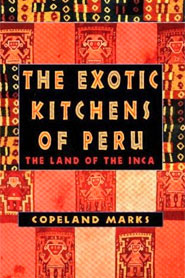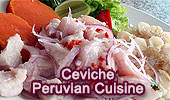|
Video Description: Aventura
Culinaria (Culinary Adventure): Aventura del Ceviche 1/2 by Gaston Acurio.
In Peru, ceviche is composed of chunks of raw fish, with lime or lemon juice though sometimes bitter orange (naranja agria), sliced onion, minced Peruvian ají limo, or the popular Andean chilli rocoto are included. The mixture is marinated and served at room temperature, often with cancha (toasted kernels of maize), usually referred to as canchita, chunks of corn-on-the-cob, slices of cooked sweet potato and/or white potato, and yuyo (seaweed). There are many regional variations. A specialty of the traditional central coast (i.e., Lima, Trujillo) is ceviche prepared from shark (tollo or toyo). Corvina (sea bass) or lenguado (sole) is also used. Many Peruvian cevicherías serve a small glass of leche de tigre or leche de pantera as an appetizer, which is a small quantity of the lime juice marinade. In its classical version, ceviche is a very simple dish: fresh sliced fish (white meat fish is better), freshly squeezed key lime juice, sliced onions, salt and chile (ají limo or rocoto).
Peruvian cuisine is considered one of the most diverse in the world. In January 2004, The Economist said that "Peru can lay claim to one of the world's dozen or so great cuisines", while at the Fourth International Summit of Gastronomy Madrid Fusión 2006, regarded as the world's most important gastronomic forum, held in Spain between January 17 and 19, Lima was declared the "Gastronomic Capital of the Americas".
|

|
|
Exotic Kitchens of Peru: The Land of the Inca by Copeland Marks.
It's little wonder that interest in Latin American eating is heating up these days. As Marks demonstrates in his latest culinary adventure (his previous cookbooks introduced us to the cuisines of Burma, India and Indonesia), Peruvian food is as rich and complex as its history. The recipes, gathered from professional chefs and home cooks, reflect this multicultural mix of the fallen Inca Empire and of the successive waves of Spanish conquerors, African slaves, Chinese laborers and Italian and Japanese immigrants who made Peru their home. Tallarin de Pollo (Spaghetti and Chicken) is seasoned with Peruvian chili peppers and cumin, while Ocopa de Camarones (Spicy Shrimp Paste with Potatoes) features the coastal shrimp alongside mountain-grown potatoes and peanuts introduced from Africa. Among the surprisingly simple recipes for ceviche--regarded as the Peruvian national dish and made of raw fresh fish marinated in citrus juices that "cook" the flesh--is one for Ceviche Japones. Carefully researched, with information on the historical and cultural significance of various dishes, the book is occasionally more appealing to read than cook from; it's probably one of the few cookbooks with a traditional Inca recipe for Cuy Frito (Crisp Fried Guinea Pigs). But Marks has easy, practical advice on how to adapt even Piranha Broth (use perch or sunfish instead) to the American kitchen, proving there's more to Peru than just small potatoes.
|

|